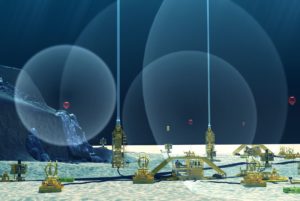
Subsea Telemetry – Nautronix
The word “Noise” resides in an etymological basket along with the words “annoyance” and “obnoxious.” “Noise” is thought to have been derived from the Latin “noxia’ (to hurt or damage), and Middle English “nausea” (to quarrel). Although some etymologies reach back to the Latin “nausea,” meaning “seasickness.” I like this origin because it hones the word to our auditory sense of balance – provided by mechanisms in our inner ears.
As used in conversational parlance, “noise” is a subjective description: Anything that interferes with my sound is noise – even if ‘my sound’ is the pounding cylinders of my Harley Davidson Bobtail. But as scientists and regulators use the term “noise” in a measured way, it must have a non-subjective definition.
For the past five years I have been participating in a gathering of experts assembled under the auspices of the International Standards Organization (ISO) taking on the task of defining the terminology we use in the description of underwater acoustics. Last week I attended (by WebEx) what could have been our closing meeting – given that we have published “International Standard ISO 18405 Underwater acoustics — Terminology.”
But having an august assembly of experts and a modicum of forward momentum, we decided to bring up a few more associated issues where metric clarification would be useful. Sitting in our collective inbox includes procedures for measurement of underwater particle motion; procedures for measurement of seabed vibration from construction projects, and the determination of insertion loss of underwater noise barriers.
While the inquiry on particle motion really interests me, there is also a suggestion that we open up the term “soundscape” to a more detailed description – to include the extents and features that constitute an “auditory scene.” This concept is reasonably well understood in terrestrial environments; it is one of the concepts that informs noise control around urban airports, for example. But in the ocean, what is described by “soundscape” is a bit more complicated.
For example: when sound can be transmitted 1500km through water, where does the “soundscape” end? Or more to the point; when marine animals have heard sounds from 1500km distant for millions of years, how far away does a sound need to be before it becomes either superfluous, or perhaps just “noise?”
So why is this important? For the last decade the geophysical industry has been pushing to survey the Atlantic Outer Continental Shelf for oil and gas deposits. The pending plan involves deploying a number of concurrent surveys in large overlapping areas. Common sense would dictate that the cumulative biological impacts of this strategy would be significantly worse than popping off a single airgun, or running a single survey.
The problem is that under the current regulatory metrics NOAA has no way of considering the impacts of concurrent or duplicative surveys. Each survey is considered as a unique event. Under this regime, the true impacts of a pile of ongoing surveys is grossly underestimated. But if we had a clear and scientifically substantiated way of expressing “Soundscape Quality,” the true impacts of ongoing surveys would become numerically “evident” and more easily subject to regulation. Specious arguments of “negligible impacts” based on diaphanous metrics would not be possible.
For this record, under ISO 18405, the definition of “Noise” is:
3.1.5.9 noise
time-varying electric current, voltage, sound pressure (3.1.2.1), sound particle displacement (3.1.2.9), or other field quantity except the signal (3.1.5.8) or signals

